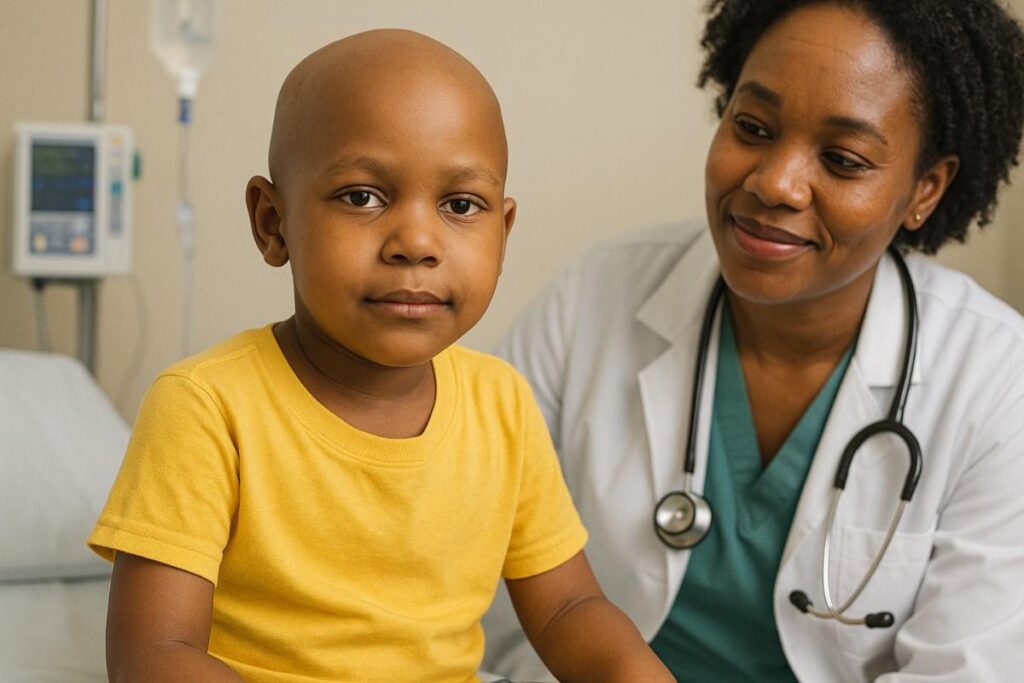Author's details
- Hakim A Abubakre
- BA (Hons) International Business Management, Msc Digital Marketing.
Reviewer's details
- Dr Afolayan Folake Moriliat
- (MBBS, MSc Tropical Pediatrics, FMCPaed) Consultant paediatrician at Kwara State Teaching Hospital, Ilorin
- Consultant paediatrician at Kwara State Teaching Hospital, Ilorin

- Date Published: 2025-03-25
- Date Updated: 2025-03-25
Childhood Cancer
Childhood cancer is one of the leading causes of death for children and adolescents. The chance of survival greatly depends on where the child lives. In richer countries, 8 out of 10 children with cancer survive, but in sub-Saharan Africa, only 3 out of 10 survive. This difference is often due to late diagnosis and lack of treatment. Several factors contribute to this disparity, including delayed diagnosis, lack of access to accurate diagnosis, limited availability of treatment, abandonment of treatment due to cost or other factors, and death due to malnutrition, not treating complications of the treatment. Despite these challenges, improving access to childhood cancer care, including essential medicines and technologies, is highly cost-effective and feasible, potentially leading to improved survival rates in all settings.
Cancer in children can present symptoms similar to those of other illnesses, making it hard to recognize early. If you notice any warning signs in your child, don’t wait—visit a doctor as soon as possible. Early detection can save lives.
- Inability to urinate or blood in the urine
- Unexplained lump, swelling, or firmness anywhere in the body
- Tummy (abdominal) pain or swelling that does not go away
- Persistent back or bone pain, especially if it wakes your child at night
- Unexplained seizures or changes in behaviour
- Frequent headaches that don’t go away
- Pale skin and constant tiredness
- Frequent infections or flu-like symptoms
- Unexplained vomiting or fever
- Shortness of breath
- Changes in the appearance of the eyes, or unusual reflections in photos
- Frequent unexplained bruising or small red or purple spots on the skin
- Unexplained weight loss
It is important to note that these symptoms are not always due to cancer but should be checked by a medical doctor to rule out serious conditions.
When a child has cancer, they need more than just medicine—they need emotional support too.
Helping with Physical Changes:
- Prepare for appearance changes: Hair loss or changes in weight can affect children’s self-esteem. Help your child prepare by letting them choose caps, or clothes that make them feel comfortable.
- Managing side effects due to treatment: Work with healthcare providers to manage pain, prevent infections, and improve your child’s quality of life.
Maintaining Friendships:
- Help your child stay connected with friends through video chats, phone calls, and messages. Friendships are important for emotional support.
- Encourage visits from friends if the child is well enough, or have a social worker guide your child on what to share with friends about their illness.
Coping with Difficult Emotions:
- Support your child through feelings of sadness or fear. Distractions like video games, art therapy, or music can help.
- Allow your child to express their feelings and let them know it's okay to feel upset. Consider talking to a psychologist or child-life specialist if they struggle with their emotions.
Adjusting to New Routines:
- Being away from school and friends during treatment can be isolating. Encourage your child to stay involved in activities they enjoy, even if they must adjust for health reasons.
- Decorate your child’s room with comforting items and encourage activities they can still participate in, such as reading, listening to music, or drawing.
If you observe any of the following symptoms in your child, contact a doctor immediately:
- Unexplained lump or swelling
- Persistent paleness and fatigue
- Frequent bruising or bleeding
- Persistent pain in one area of the body
- Unexplained fever or infection
- Sudden vision changes or headaches
- Sudden unexplained weight loss
These symptoms may not always be due to cancer but require a medical doctor’s evaluation to rule out serious conditions.
While not all childhood cancers can be prevented, certain steps can reduce the risk:
- Sun safety: Protect children from harmful UV rays by using sunscreen and avoiding excessive sun exposure.
- Vaccination: Ensure your child receives vaccinations, especially for Human Papillomavirus (HPV), which can prevent certain types of cancer.
- Healthy habits: Encourage physical activity and a balanced diet to maintain a healthy weight.
- Avoid smoking: Educate your child about the dangers of smoking and exposure to tobacco.
In sub-Saharan Africa, early detection, access to treatment, and supportive care are essential in improving childhood cancer survival rates. Parents, caregivers, and communities play a vital role in recognizing warning signs, seeking timely medical help, and providing emotional support to children undergoing cancer treatment. Many people believe that childhood cancer is always fatal or that it’s contagious. With early medical visits could many lives saved. Cancer is not an infectious disease that spread by having contact with cancer patients.
- World Health Organization. Childhood cancer. February 2025. Available at: https://www.who.int/news-room/fact-sheets/detail/cancer-in-children
- National Collaborating Centre for Cancer (UK). Suspected Cancer: Recognition and Referral. London: National Institute for Health and Care Excellence (NICE); 2015 Jun. PMID: 26180880.
- National Cancer Institute. Children with Cancer A Guide for Parents. September 2015. Available at: https://www.cancer.gov/publications/patient-education/guide-for-parents. Accessed March 2025
- National Cancer Institute. Support for Families: Childhood Cancer. September 2023. Available at: https://www.cancer.gov/about-cancer/coping/caregiver-support/parents#cope. Accessed March 2025
